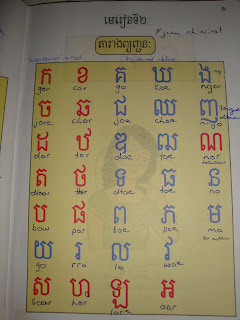Actually, I'm still nailing the alphabet - and thought it was about time that I introduced you to my journey of learning Khmer script. If you have a cup of coffee and ten minutes to kill, then feel free to engage your brain and step into my language world for a bit.

The blessed consonants
Every consonant has a built-in vowel sound. We have a 'k' sound; the Khmer consonants (yep, plural ..) sound 'core' or 'co', depending on whether it is a first-series consonant (the red ones in the alphabet picture) or a second series consonant (the blue ones). The 't' sound is a bit sadder - four consonants start with a 't' sound and a further two have a 'dt' sound. Which one to choose in spelling is still a complete lottery to me.
But wait, there's more. The pronunciation of each consonant changes with the vowel used. My sweet mother-tongue language has five vowels. Khmer is a wee more complicated - there are 23 vowels. Every vowel will alter the consonant pronunciation. Many of the subtleties are indistinguishable to my old ears. That leads you to the times when people helpfully correct you - when what they say and what I think I have said are identical. But no, it is different.

... and the blessed vowels
23 vowels are obviously not enough. So, to correct this deficiency, 17 of the 23 vowels have a different sound when used with first-series consonants to when they are used for second-series consonants. Check out the first vowel like a reversed 'r'. Following a red letter, it changes the 'ore' sound (that is built-in; remember?) to an 'ar' sound. Following a blue (second series consonant) letter, the consonant is pronounced with an 'ee-a'.
So, now we have 40 vowel sounds to play with. Vowels here are very random animals. In placement with the consonant, they can appear over, under, before, after or a combination of the above (seeing many vowels have two and yay, even three, parts to the one vowel).

No blessing at all in these little guys - in black and in light blue are the subscript consonants.
OK lets string a bit together. Check out a simple one - 'hallelujah'. We assemble it like thus:

mmm, that's a bit messy; I hope you get the drift ...
If your coffee has made you extra-bright, you possibly picked up that the 'y' is a second-series consonant, and so the attached vowel should be an 'ee-a' sound (halleluyeea??) That's where the little " above (they are called 'rats teeth') change things - when they show up, they change the vowel sound of a second-series consonant to that of a first-series consonant. I guess you are figuring by now that there are a whole lot of dirty tricks in this written language! And - I'm still discovering more ...
Secondly, take the word for 'eye' - 'p'nairk'. How much trouble can you get out of a three-lettered English word?? Here is how it pans out.

'P'nairk' - eye

So, in this case the progression goes from the second letter, down to the subscript, back to the first letter which is the vowel for the subscript and then to the final consonant - the 'g' which gets pronounced 'k' at the end of most words. Well, not quite - Khmer is notorious for dropping off the final 'hard' sound of a work so 'eye' comes out more like 'p'nair' with the hint of a 'k' sound at the end.
18 months ago, I had no heart for trying to learn the written stuff. Just give me the conversation. A year plus down the road, and I was hitting just too many blocks. Some people learn great by listening and learning. I wasn't.
I discovered that I need visual structure in order to sort out pronunciation. I have to see and nut it out in order to comprehend. There is plenty to see too - there are no gaps between words, so everything runs together. It is a real slow magical mystery tour but I'm actually finding more go-forward by backing up and getting some alphabet handles.
No comments:
Post a Comment